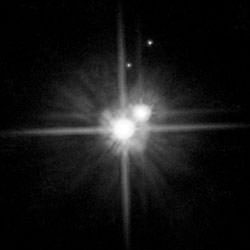
Pluto and its three moons. Image credit: Hubble. Click to enlarge.
New photographs from the Hubble Space Telescope provide evidence that Pluto and its three moons probably formed at the same time, out of the same material. Scientists believe that the 4 objects were created when two Pluto-sized Kuiper Belt objects collided together. Hubble revealed that that Pluto and its moons have identical colours; exactly what you’d expect from this kind of an origin.
Using new Hubble Space Telescope observations, a research team led by Dr. Hal Weaver of the Johns Hopkins University Applied Physics Laboratory and Dr. Alan Stern of Southwest Research Institute has found that Pluto’s three moons are essentially the same color – boosting the theory that the Pluto system formed in a single, giant collision.
Publishing their findings in an International Astronomical Union Circular (No. 8686), the team determined that Pluto’s two “new” satellites, discovered in May 2005 and provisionally called S/2005 P 1 and S/2005 P 2, have identical colors to one another and are essentially the same, neutral color as Charon, Pluto’s large moon discovered in 1978.
All three satellites have surfaces that reflect sunlight with equal efficiency at all wavelengths, which means they have the same color as the Sun or Earth’s moon. In contrast, Pluto has more of a reddish hue.
The new observations were obtained March 2 with the high-resolution channel of the Hubble’s Advanced Camera for Surveys. The team determined the bodies’ colors by comparing the brightness of Pluto and each moon in images taken through a blue filter with those taken through a green/red filter. The images are available on the Hubble Web site at http://hubblesite.org/newscenter/newsdesk/archive/releases/2006/15/image/.
“The high quality of the new data leaves little doubt that the hemispheres of P1 and P2 that we observed have essentially identical, neutral colors,” says Weaver.
The new results further strengthen the hypothesis that Pluto and its satellites formed after a collision between two Pluto-sized objects nearly 4.6 billion years ago. “Everything now makes even more sense,” says Stern. “If all three satellites presumably formed from the same material lofted into orbit around Pluto from a giant impact, you might well expect the surfaces of all three satellites to have similar colors.”
The researchers hope to make additional Hubble color observations, in several more filters, to see if the similarity among the satellites persists to longer (redder) wavelengths. They have proposed to obtain compositional information on the new satellites by observing them at near-infrared wavelengths, where various ice and mineral absorptions are located. The researchers also hope to better refine the orbits of P1 and P2 and measure the moons’ shapes and rotational periods.
The Hubble observations were made in support of NASA’s New Horizons mission to Pluto and the Kuiper Belt. New Horizons launched on Jan. 19, 2006, and will fly through the Pluto system in July 2015, providing the first close-up look at the ninth planet and its moons. Stern leads the mission and science team as principal investigator; Weaver serves as the mission’s project scientist. The Johns Hopkins University Applied Physics Laboratory, Laurel, Md., manages the mission for NASA’s Science Mission Directorate and operates the New Horizons spacecraft. For more information on the mission, visit http://pluto.jhuapl.edu.
The other members of the Hubble Space Telescope-Pluto satellite observing team include Max Mutchler of the Space Telescope Science Institute, Baltimore; Drs. William Merline, John Spencer, Andrew Steffl, Elliot Young and Leslie Young of Southwest Research Institute, Boulder, Colo.; and Dr. Marc Buie of Lowell Observatory, Flagstaff, Ariz.
Original Source: JHUAPL News Release
Update: Pluto is not a planet.
